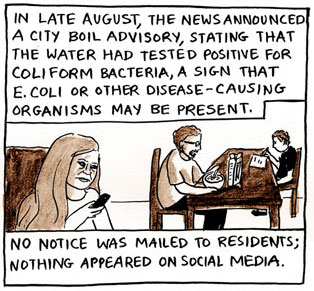 For many, water crises don’t get any more horrifying than what was initiated by city officials in Flint, Michigan when they switched the city’s water supply almost three years ago, a story we explore in the second of our ongoing comics series on water, land and housing in the state (read the first here), below. While the Flint water crisis remains a popular touchstone, a useful example to consider in light of rampant government misspending and corruption, few understand what the ongoing crises really means — or how they might identify signs of similar contamination in their own homes.
For many, water crises don’t get any more horrifying than what was initiated by city officials in Flint, Michigan when they switched the city’s water supply almost three years ago, a story we explore in the second of our ongoing comics series on water, land and housing in the state (read the first here), below. While the Flint water crisis remains a popular touchstone, a useful example to consider in light of rampant government misspending and corruption, few understand what the ongoing crises really means — or how they might identify signs of similar contamination in their own homes.
The biggest problem with Flint has always been identifying what the problem even is. The media narrative about lead levels focuses attention on contaminants more severe in 3,000 other US cities; too, the increasing evidence of bacterial infections, including deadly Legionella get ignored. Ongoing government noncompliance and backroom deals halt any progress the city could be making to limit the effects of the crisis, which makes even good news like the EPA’s $100 million grant for infrastructure improvements fall a little flat. The deeply flawed emergency management law, under which both Flint and Detroit’s crises emerged almost overnight, is still on the books. And threats to repeal the ACA [Affordable Care Act] — particularly Michigan’s expanded Medicaid program — throw into jeopardy all progress made by residents to reconstruct their health and their lives.
And yet, as in Detroit, brilliant women in Flint are leading the national conversation about water rights. Have questions about what’s really going on in Flint? Meet Melissa Mays in this month’s strip, “There’s No Way We’re Gonna Drink That.”



- Personal interview with Melissa Mays, conducted on February 21, 2017.
- “2 former Flint emergency managers charged over tainted water,” Monica Davey and Mitch Smith, The New York Times, December 20, 2016. Accessed March 1, 2017: https://www.nytimes.com/2016/12/20/us/flint-water-charges.html?_r=0
- “City warns of potential health risks after Flint water tests revealed too much disinfection byproduct,” Ron Fonger, MLive, January 2, 2015. Accessed February 28, 2017: https://www.mlive.com/news/flint/index.ssf/2015/01/flint_water_has_high_disinfect.html
- “Michigan attorney general sues France’s Veolia in Flint water crisis,” Ben Clayman, Reuters, June 22, 2016. Accessed February 28, 2017: https://www.reuters.com/article/us-michigan-water-idUSKCN0Z81PD
- “Federal judge orders delivery of bottled water in Flint,” Paul Egan, Free Press, November 10, 2016. Accessed March 1, 2017: https://www.freep.com/story/news/local/michigan/flint-water-crisis/2016/11/10/delivery-bottled-water-flint/93613760/
- “Soaring pneumonia deaths in Genessee County likely linked to undiagnosed Legionnaire’s, experts say,” Chastity Pratt Dawsey, Bridge, January 26, 2017. Accessed March 1, 2017: https://www.bridgemi.com/children-families/soaring-pneumonia-deaths-genesee-county-likely-linked-undiagnosed-legionnaires
- “Flint: ‘All clear’ for drinking water years away,” Jonathan Oosting, Detroit News, March 7, 2107. Accessed March 16, 2017: https://www.detroitnews.com/story/news/michigan/flint-water-crisis/2017/03/07/flint-water-conference/98862674/
Copyright Anne Elizabeth Moore and Melissa Mendes 2017.
We have 7 days to raise $45,000 — we’re counting on your support!
For those who care about justice, liberation and even the very survival of our species, we must remember our power to take action.
We won’t pretend it’s the only thing you can or should do, but one small step is to pitch in to support Truthout — as one of the last remaining truly independent, nonprofit, reader-funded news platforms, your gift will help keep the facts flowing freely.